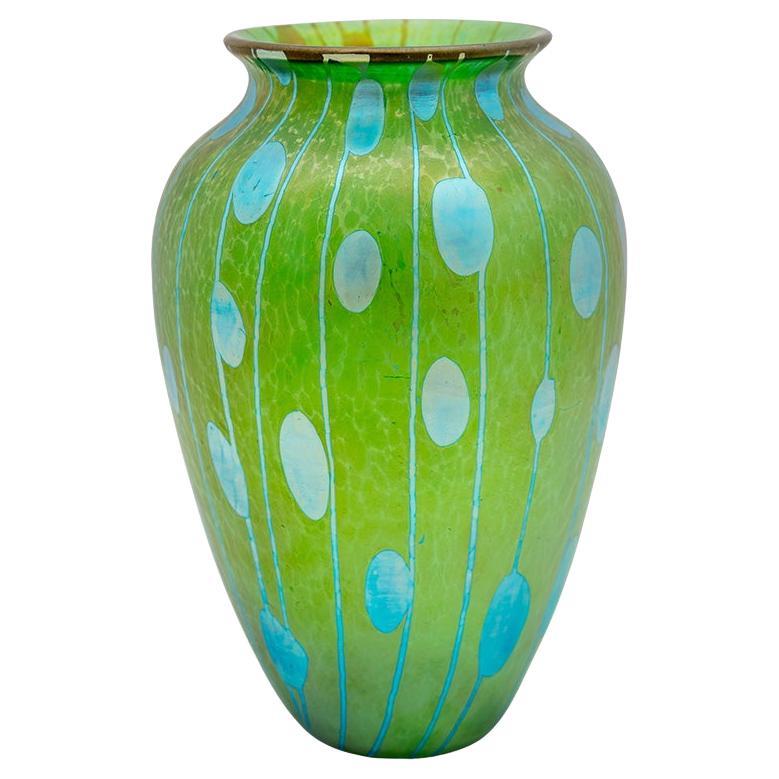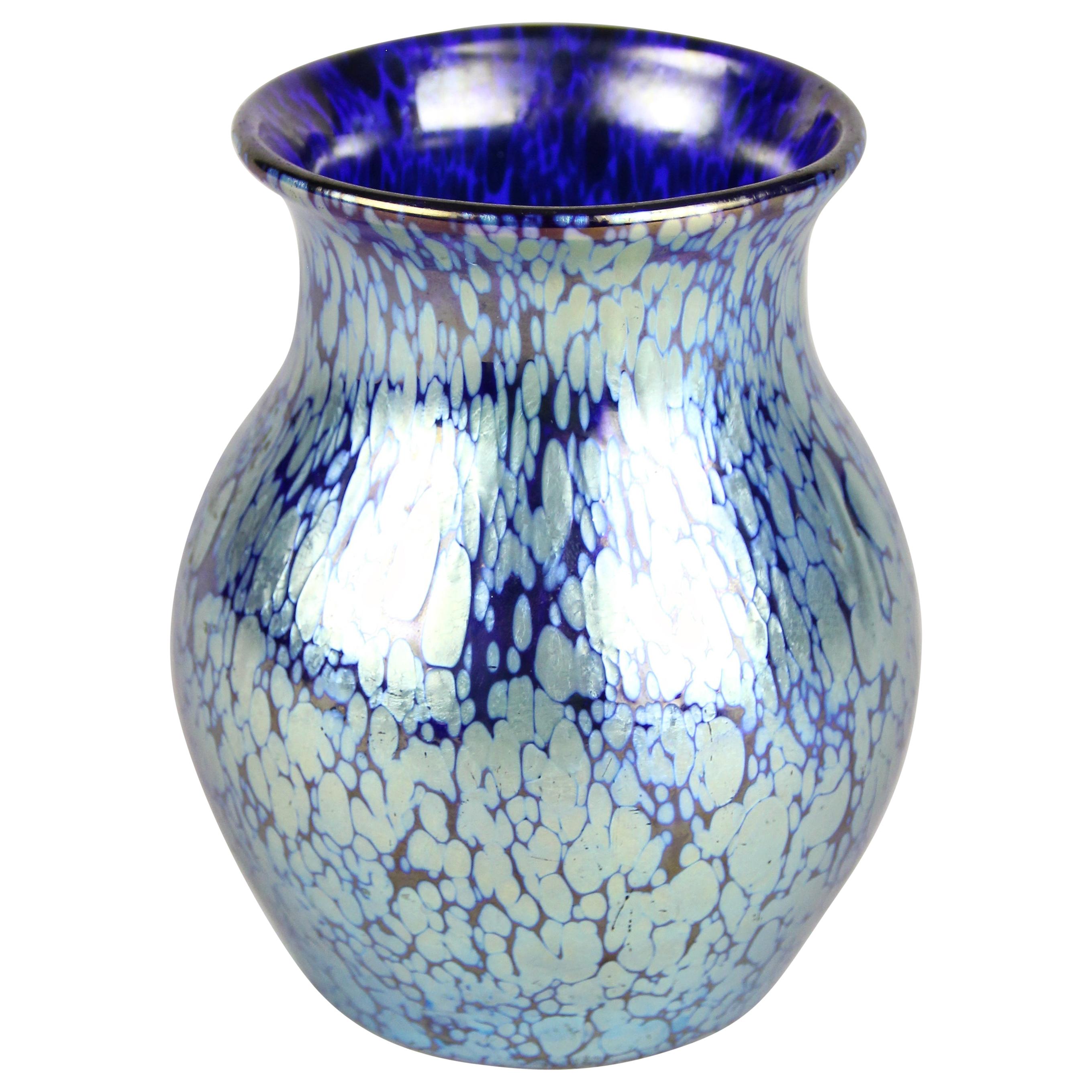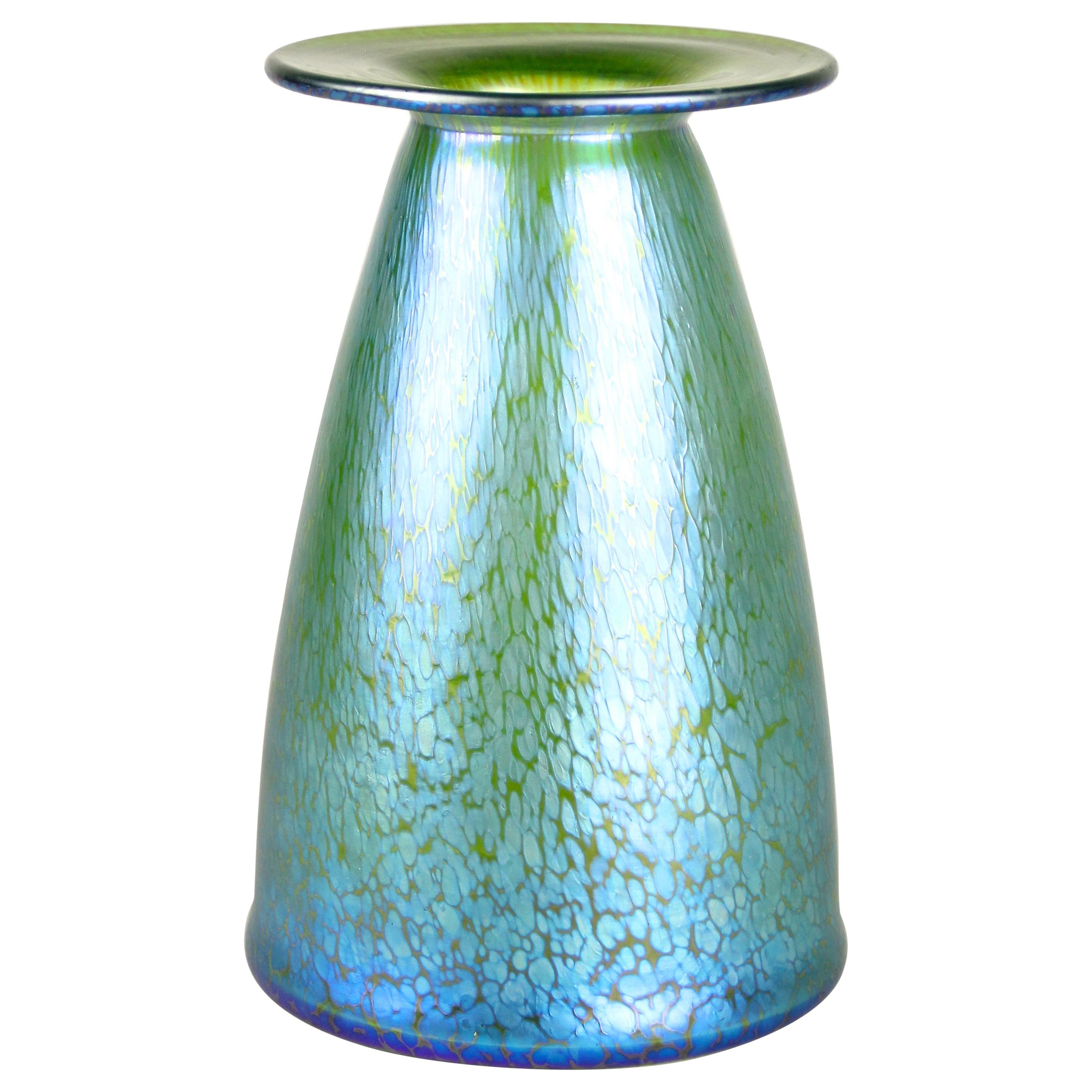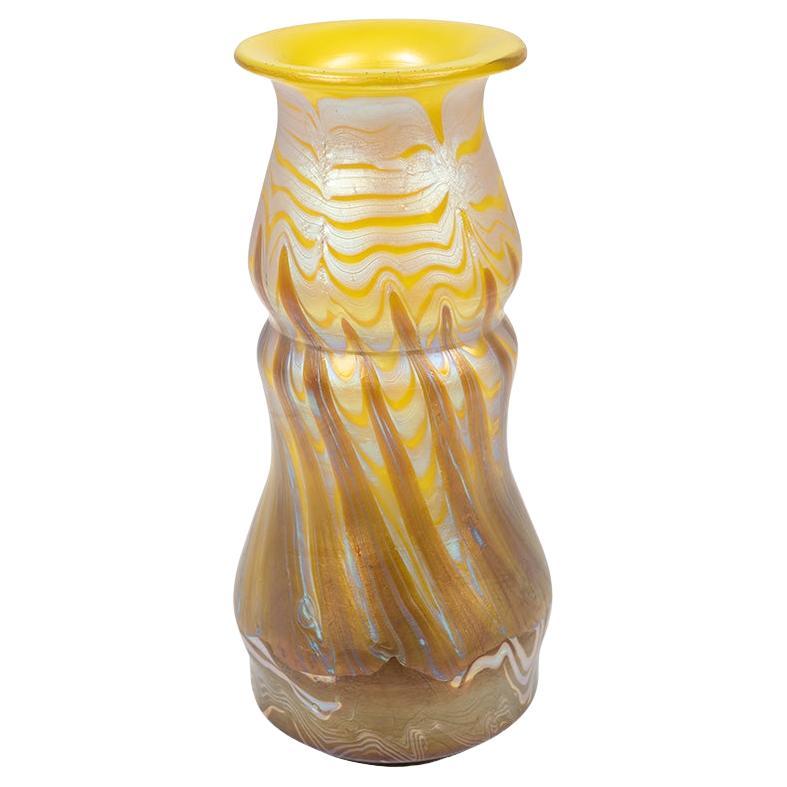Koloman Moser Art Nouveau Glass Pitcher by Loetz Witwe, Bohemia, 1900s
About the Item
- Creator:
- Dimensions:Height: 6 in (15.24 cm)Width: 4 in (10.16 cm)Depth: 3.5 in (8.89 cm)
- Style:Art Nouveau (Of the Period)
- Materials and Techniques:
- Place of Origin:
- Period:1900-1909
- Date of Manufacture:1900
- Condition:
- Seller Location:Vienna, AT
- Reference Number:1stDibs: LU1015233055182
Koloman Moser
Born in Vienna in 1868, Koloman Moser briefly attended trade school, honoring his father’s wish to see him in commerce. But he soon surrendered to his artistic inclinations, enrolling in 1885 in Vienna’s Academy of Fine Arts, where he studied painting.
When his father died unexpectedly in 1888, leaving the family in financial straits, Moser (1868–1918) helped out by doing illustrations for books and magazines. Meanwhile, he continued his painting studies, at the academy and then at the School of Arts and Crafts, starting in 1892. That was also the year that Moser, along with other young artists revolting against the Viennese art world’s devotion to naturalism, formed the Siebner Club, the precursor to the Vienna Secession.
Moser’s introduction during his last term at school to Gustav Klimt’s Allegory of Sculpture proved a turning point for the young artist. Christian Witt-Dörring, guest curator of the 2018–19 exhibition “Koloman Moser: Universal Artist between Gustav Klimt and Josef Hoffmann” at the MAK in Vienna, noted a change in the artist’s drawing style. “Primarily inspired by the art of Japan, [Klimt] introduces new paper sizes, fragmented image details, and an emphasis on the line as opposed to the surface,” wrote Witt-Dörring in the exhibition’s catalogue.
A year later, in 1897, Moser together with Klimt, Carl Moll, Joseph Olbrich and Josef Hoffmann founded the Vienna Secession, a union of artists and designers determined to upend Austria’s artistic conservatism. The members were committed to making total works of art: Gesamtkunstwerken. Looking to the English Arts and Crafts Movement, with its guiding principle of unity of the arts, the group attempted to bring art back into everyday life and introduce a local modernism to fin-de-siècle Vienna. Moser, whose membership in the club also afforded him entry into upper-class Viennese society, turned his back on oil painting and forged ahead with Gesamtkunstwerk.
Moser created everything from exhibition design to facade ornamentation for the Secession Building, to graphic materials. Moser also produced posters and advertisements in his “modern style” for various companies. In 1898, he presented his first decor pieces, including hand-knotted rugs and cushion covers. In 1899, Moser began what would become a lifelong professorship at the School of Arts and Crafts. His repertoire now expanded to include furniture, ceramics and patterns like his trademark checkerboard design. He also moved into scenography and fashion and established himself as an interior designer.
The artist decorated his own home in 1902, after which he received a series of important commissions, notably the villa of textile industrialist Fritz Waerndorfer. It was Waerndorfer who provided the financial support that enabled Moser and Hoffmann in 1903 to found the Wiener Werkstätte, a platform for fully realizing their ideal of Gesamtkunstwerk. Two years later, Moser married Edith Mautner von Markhof, the daughter to one of Austria’s great industrial barons, and his work thrived.
In 1907, the Wiener Werkstätte ran into financial trouble. Losing faith in the unity of the arts and disillusioned with the group’s dependency on wealthy patrons like Waerndorfer, Moser left the Werkstätte. He returned to his original discipline, painting, which he continued to practice until his untimely death from cancer, in 1918.
Today, Koloman Moser’s work, from his metal vases to his jewelry to his interiors, remains sought-after and revered. Browse Moser's radically modern creations at 1stDibs.
- ShippingRetrieving quote...Ships From: Vienna, Austria
- Return PolicyA return for this item may be initiated within 7 days of delivery.
- Koloman Moser Art Nouveau Meteor Bowl With Silver Rim, Bakalowits Vienna, 1900sBy Bakalowits & Söhne, Wiener Werkstätte, Koloman MoserLocated in Vienna, ATA beautiful Art Nouveau Vienna Secession mouth-blown „Meteor“ optical glass bowl with a rim made of silver-plated brass from the early 1900s. Designed by Koloman Moser (1868 - 1919),...Category
Antique Early 1900s Austrian Art Nouveau Decorative Bowls
MaterialsBrass
- Carl Auböck Boot Pitcher, Vase, Drinking Glass with Brass Spur, Austria, 1950sBy Werkstätte Carl AuböckLocated in Vienna, ATA sculptural pitcher / vase / caraffe / big drinking glass in the shape of a big boot with a handcrafted brass spur. Designed and executed in the 1950s by Carl Auböck Vienna, Austri...Category
20th Century Austrian Mid-Century Modern Glass
MaterialsBrass
- Purtilo Glass Pitcher Carafe by Kaj Franck for Nuutajärvi Notsjö, Finland, 1950sBy Nuutajärvi Notsjõ, Kaj FranckLocated in Vienna, ATA beautiful Purtilo glass pitcher, model 1609, in greenish amber color from the 1950s. Designed by Kaj Franck, executed by Nuutajärvi Notsjö in Finland. In very good condition.Category
Mid-20th Century Finnish Mid-Century Modern Pitchers
MaterialsGlass, Art Glass
- Rare Carl Auböck Martini Newspaper Glass Pitcher, Austria, 1950sBy Werkstätte Carl AuböckLocated in Vienna, ATA beautiful glass pitcher from the 1950s, designed and executed by Carl Auböck, Austria. Usually these pitchers have a leather belt, but this one has a lovely newspaper decor on its ...Category
20th Century Austrian Mid-Century Modern Barware
MaterialsBrass
- Carl Auböck Midcentury Black Leather Glass Pitcher, Excellent "As New" ConditionBy Werkstätte Carl AuböckLocated in Vienna, ATAn elegant martini glass pitcher with black leather handle in excellent condition. We think, it is unused.Category
Mid-20th Century Austrian Mid-Century Modern Barware
MaterialsLeather, Glass
- French Art Nouveau Salt and Pepper Shakers, Facetted Crysta Glass from the 1920sLocated in Vienna, ATA set of beautiful Art Nouveau salt and pepper shakers, made of facetted glass. Made in France in the 1920s, in excellent condition.Category
Vintage 1920s French Art Nouveau Tableware
MaterialsCrystal
- Bohemian Glass Vase Loetz Koloman Moser circa 1900 Blue GreenBy Koloman Moser, Loetz GlassLocated in Klosterneuburg, ATBohemian glass vase, manufactured by Johann Loetz Witwe, Flecken und Streifen decoration, ca. 1900, Green, Blue, Viennese Art Nouveau, Jugendstil, Art Deco, art glass, iridescent gla...Category
Antique Early 1900s Austrian Jugendstil Glass
MaterialsGlass
- Iriscident Art Nouveau Glass Vase by Loetz Witwe, Bohemia, circa 1902By Johann Lötz WitweLocated in Lichtenberg, ATExceptional Art Nouveau glass vase by Loetz Witwe Klostermuehle, Bohemia, circa 1902. This absolute rare, iriscident Loetz vase shows an unusual shaped body with a beautiful green gl...Category
Early 20th Century Czech Art Nouveau Glass
MaterialsBlown Glass
- Loetz Witwe Art Nouveau Glass Vase Decor Cobalt Papillon, Bohemia, circa 1903By Johann Lötz WitweLocated in Lichtenberg, ATVery decorative Loetz Witwe glass vase in decoration Cobalt Papillon from the Art Nouveau period in Bohemia, circa 1903. This gorgeous vase from the workshops in Klostermuehle shows ...Category
Early 20th Century Czech Art Nouveau Vases
MaterialsBlown Glass
- Loetz Glass Vase "Crete Papillon" by Koloman Moser for E. Bakalowits, circa 1899By Koloman Moser, Johann Lötz WitweLocated in Lichtenberg, ATStunning Loetz glass vase by Koloman Moser for E. Bakalowits made in Klostermuehle/ Bohemia, circa 1899. This rare Bohemian glass vase was designed by none other than world-famous Au...Category
Early 20th Century Czech Art Nouveau Glass
MaterialsBlown Glass
- Vase Loetz , Style : Art Nouveau , Bohemia, circa 1900By Loetz GlassLocated in Ciudad Autónoma Buenos Aires, CLoetz The glass factory, originally founded in 1836 by Johann Baptist Eisner, was taken over. Loetz was the premier Bohemian glass works during this period. It was located in Klostermühle, near Rejštejn in the Sušice district in South-West Bohemia, which belonged to the Austro-Hungarian Empire until 1918. Susanna Loetz, widow of Glass entrepreneur Johann Loetz in 1852. She renamed the company "Glasfabrik Johann Loetz Witwe", a name that was retained until all activities were stopped in 1947. In 1879 it passed to Max Ritter von Spaun. Under his guidance, together with director Eduard Prochaska, the glassworks flourished as never before and enjoyed its most successful period. Von Spaun and Prochaska concentrated on the development of innovative glass types and new production techniques. Their first successful speciality was a glass type simulating semiprecious stones. It is often called "Marmoriertes Glas" ("marbled glass"). The range contained Onyx (red/brown), Karneol (red/pink) and later Malachit (green). It was introduced in the second half of the 1880's. From the same period dates the Octopus glass, of which the decor resembles the tentacles of a cephalopod. The production of Marmorier-tes Glas was resumed in 1906, in different colours like yellow and white. Octopus, 1885-1890, 1885-1890, unknown, an Malachit, 1885-1890, unknown, The master glass-blowers of Klostermühle had already carried out experiments with iridescence in the first half of the 1890's, and they produced the Olympia, a classically inspired olive green type, in 1896. Similar, in variants of creta green, bronce or Olympia and averse to any redundant decoration was the Glatt decor. It highly contrasted with the more elaborate finishes of that time, but it constitutes a part of the production with a deep sense for taste and quality. Most of the pieces shown in the "Glatt" decors were manufactured for Max Emmanuel in London. The glatt decor remained in use for many years. The Chiné decor had thin glass threads spun around the body in irregular patterns. It is not to be confused with the type of glass that was produced by Kralik. Loetz "Chiné" came in clear, opal, green and pink, Kralik "Chiné" in dark purple. The logical sequel to Chiné was the Pampas decor, green or cobalt blue, in which the threads almost disappeared in the surface, with iridised parts in between. Around the same time the dotted Papillon decor was introduced. The beautiful silver spots were employed on a wide array of models and quite effective on the gooseneck (water sprinkler) and sea shell...Category
Antique Early 1900s Austrian Art Nouveau Glass
MaterialsArt Glass
- Signed Glass Vase Loetz Decoration circa 1900 Art Nouveau Jugendstil BohemiaBy Loetz GlassLocated in Klosterneuburg, ATBohemian glass vase, manufactured by Johann Loetz Witwe, PG 356 decoration, ca. 1900, signed, Paris World Exhibition, orange, brown, ochre, silver, white, Bohemia, Viennese Art Nouve...Category
Early 20th Century Austrian Jugendstil Glass
MaterialsGlass






